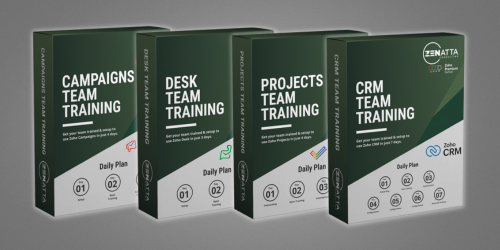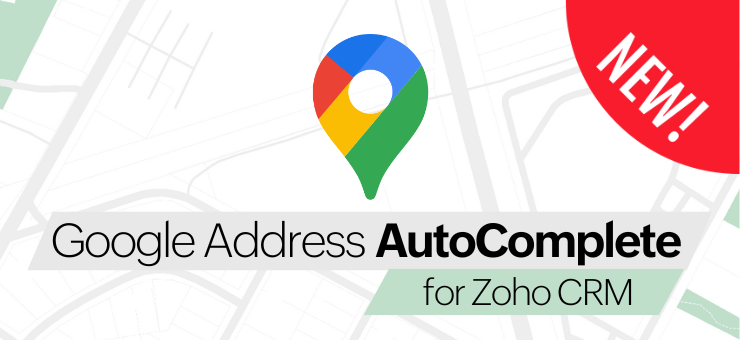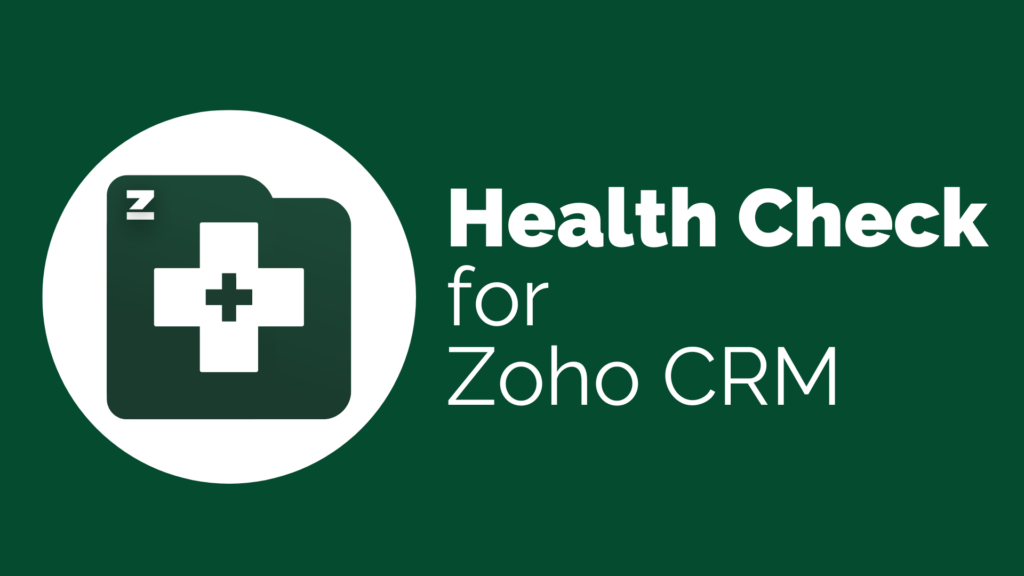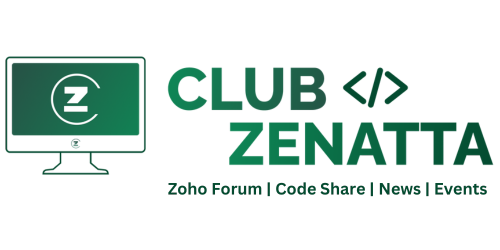Originally launched in 2024, Zoho CRM for Everyone introduced a major redesign in how teams interact with and manage their CRM workflows. Now, in 2025, we’re revisiting this powerful update to walk through its most impactful features — from the streamlined UI and flexible team spaces to new ways to organize modules, automate tasks, and manage permissions.
Whether you’re just starting with Zoho CRM or looking to optimize your current setup, this guide will help you understand what’s new, what’s changed, and how to fully leverage Zoho CRM for Everyone in 2025.
Updated User Interface
Right out of the gate, you’ll notice things look different. The updated interface in Zoho CRM for Everyone isn’t just a visual makeover—it’s a reorganization designed to simplify navigation and make the platform more intuitive for every type of user.
Left-Hand Navigation Gets a Purpose-Driven Refresh
Here’s what now lives in the left-side menu:
- Modules – The core building blocks of CRM. Nothing new here, but easier to locate.
- Reports & Analytics – Now separated for clarity, making it easier to distinguish raw tabular reports from graphical dashboards.
- My Requests – A new section for managing record requests (more on this when we cover Team Modules).
- Marketplace – A cleaner path to integrations and plugins.
- Search – Still global. Still essential.
Longtime users will also notice that system Settings have migrated away from the classic grid view. Instead, they now live in a sidebar, categorized and searchable.
Pro tip: Use the search bar—scrolling through the list is a sure way to miss something crucial.
Key Settings Reorganized for Better Access
Settings are now grouped under intuitive categories like:
- General – Personal preferences, company info, business hours.
- Users & Security – User roles, profiles, single sign-on, territory management.
- Customization – Modules, pipelines, wizards, and canvas views.
- Automation – Workflows, blueprints, signals, and process management tools.
- Data Admin – Import/export, recycle bin, data backups, admin cleanup tools.
- Developer Hub & Zia AI – API scripts, prompt builders, and CPQ tools.
The updated UI promotes a “less is more” approach—clutter is out, and simplicity is in.
What’s New in Zoho CRM for Everyone?
So what exactly changed in this year’s rollout? While some of it is cosmetic, other updates open the door to completely new ways of organizing teams and controlling access. Let’s walk through the biggest upgrades you’ll notice in Zoho CRM for Everyone.
#1: Team Spaces — More Than Just Tab Groups
Team Spaces might sound familiar to seasoned users—after all, it’s not far off from old-school tab group functionality. But Zoho has added a layer of finesse here.
You can now:
- Organize modules into collapsible folders (e.g., “Support Records,” “Customer Accounts,” or “Activities”).
- Create custom Team Spaces for departments like Sales, Support, or Fulfillment.
- Assign visibility based on profiles or roles—not individual users, which saves major admin time.
- Nest modules inside folders for a cleaner interface and quicker access.
If your CRM has ever overwhelmed users with too many modules at once, this change is a breath of fresh air.
#2: Team Modules — Mini Admin Zones for Power Users
One of the standout additions in Zoho CRM for Everyone update is Team Modules—custom modules with enhanced permission flexibility.
Here’s how they work:
- Team Modules look and behave just like regular custom modules—but with added access controls.
- You can assign Managers, Members, Participants, and Requesters, each with distinct levels of permission:
- Managers = module-level admin rights
- Members = can view and update their own + all team records
- Participants = limited to viewing/editing their own entries
- Requesters = users who can submit data that must be approved before becoming a formal record
Why does this matter? It lets you hand off partial admin control without opening up your entire CRM to risky changes.
One use case: a support team managing escalations. The Team Module setup allows for controlled record creation, approval, and collaboration without affecting other teams or modules.
#3: Cleaner Module Creation with Context-Aware Access
When creating new modules, you now choose between:
- Org Modules – Visible across the whole organization.
- Team Modules – Scoped only to the teams that need them.
This added distinction cuts down on clutter and confusion, particularly for larger orgs or companies with siloed operations.
#4: Folders Inside Modules — A Game Changer for UX
It might sound small, but being able to nest modules inside labeled folders brings a massive boost in usability. Grouping related modules (e.g., “Accounts,” “Contacts,” and “Deals” under “Customers”) helps users locate what they need—fast.
It’s especially helpful in implementations with lots of custom modules or specialized workflows. Organize by department, function, or funnel stage.
Core Configurations
Now that you’ve seen what’s new in Zoho CRM for Everyone, let’s look into the foundational settings that every team should review when setting up—or revisiting—their CRM. These core configurations are the building blocks for data security, process control, and long-term usability.
Profiles & Roles: Lock It Down
By default, Zoho CRM hands out more access than you might expect. Even users with the standard profile can create and customize modules—yikes. That’s why it’s critical to:
- Create custom profiles tailored to each role.
- Remove permissions for things like deleting records or configuring back-end modules.
- Enable only what’s necessary, like setting up email or calendar syncs.
Think of profiles as a least-access-first strategy. If someone hits a wall, it’s easier to add permission than to undo damage from too much access.
Roles, on the other hand, handle data visibility. They define who can see what across your org by creating a hierarchy where:
- Data flows upward (e.g., Sales Reps → Sales Managers → Sales Director).
- Access is limited by design unless explicitly opened through data sharing rules.
These two tools—Profiles and Roles—are your gatekeepers. Use them wisely.
IMAP & Email Integrations: Don’t Skip It
Zoho makes it easy to connect Gmail, Outlook, or other IMAP accounts so that every email sent or received appears directly inside the CRM. This ensures:
- Everyone stays on the same page.
- No leads or customer messages fall through the cracks.
- You get full visibility without flipping between apps.
Unless you work in a highly regulated industry, this setup is a no-brainer.
PhoneBridge: Pick the Right Calling Tool
Planning to make calls directly from CRM? Use a PhoneBridge-compatible provider. Why?
- Native Zoho PhoneBridge integrations automatically log calls, missed attempts, and durations.
- It works across CRM, Desk, and Recruit.
- You can trigger workflows or follow-ups based on call outcomes.
Rather than building a custom solution, start by browsing the Marketplace > Telephony section to find a fit that just works.
Customizing Modules: Clean Data Is Happy Data
Here’s where the magic happens. When building out your CRM, use:
- Picklists instead of open-text fields to enforce consistent data.
- Sections to visually group fields (e.g., “Scoring Info,” “Customer Details”).
- Layout rules to show/hide fields based on a lead’s type or status.
Pro tip: The more clean and structured your data is now, the more powerful your reports and automations will be later.
Workflow Rules in Zoho CRM for Everyone
With Zoho CRM for Everyone, workflow automation remains the heart of efficient process management. The interface hasn’t changed much, but the potential for impact? Still huge.
Here’s a quick breakdown of what you can automate:
Trigger Types You Can Use
- Record Actions – On create, edit, or delete.
- Date/Time-Based – Run a task one day after a deal is created, for example.
- Score Changes – Trigger alerts if a lead’s score jumps (or drops).
- Note Updates – Yes, you can trigger workflows when someone updates a note field.
Say you want a task to be created anytime a new lead comes in from a seminar or partner channel. No problem. Build the filter condition → assign the task → set the due date → notify the owner.
Pro tip: If lead assignment happens after task creation, your automation might assign it to the wrong person. Avoid this by using a scheduled action (e.g., 2 minutes later) to ensure the correct owner is set first.
This kind of nuance is what makes Zoho workflows incredibly flexible—but also a bit dangerous if misconfigured. Start simple. Then layer on the complexity.
Build Smarter Lists with Custom Views
Let’s be honest: the default lead view in Zoho CRM? It’s fine. But it won’t help your team prioritize, plan, or stay on top of follow-ups.
That’s where custom views come in. And with the Zoho CRM for Everyone layout, creating and managing them is smoother than ever.
A Good Custom View Should…
- Filter down by stage, status, owner, or last activity.
- Group records into actionable lists (e.g., “Hot Leads,” “No Contact in 7 Days”).
- Exclude noise, like junk or disqualified leads.
One of our favorite power combos? Add a filter for leads where “Last Activity Time” is greater than 7 days. That way, reps can work from a “touch base” list that dynamically updates as they engage (or forget to).
Then layer on:
- Lead Source = “Partner”
- Status ≠ “Junk”, “Lost”, or “Not Qualified”
- Shared only to specific roles or profiles
- Locked columns to keep the view consistent
This transforms a raw CRM list into a daily playbook for reps. It’s a productivity booster and a training tool rolled into one.
Visualize Everything: Reports, Dashboards, and Homepages in Zoho CRM for Everyone
You’ve built your custom fields. You’ve locked down workflows and cleaned up views. Now it’s time to actually see what’s going on—and that’s where reports and dashboards come in. With the 2025 version of Zoho CRM for Everyone, these tools are cleaner and better organized, making it easier than ever to surface the insights your teams need.
Zoho Reports: Your Tabular Data Workhorse
Let’s start simple. Reports are tabular lists of records, often combining parent/child modules like:
- Accounts + Deals
- Leads + Tasks
- Contacts + Activities
You can group data (e.g., by deal stage), run aggregate calculations (like total revenue or number of tasks), and filter to get hyper-specific segments.
? Pro tip: If you’re building a report that only needs records with activity—like “Deals with Tasks”—be sure to use the exclusive child module option. That way, it excludes deals without associated tasks.
Zoho Dashboards: Turn Reports Into Eye Candy
Dashboards are the next level up. They give you:
- Funnel charts to visualize pipeline progress
- Comparators for win/loss performance
- Quadrants, cohorts, targets, and more
A key improvement in Zoho CRM for Everyone? The ability to build dashboard components directly from saved reports. This gives you more control and unlocks clickable drill-downs into raw data.
Seriously—if you’re still building charts from scratch, you’re missing out. Always start with a report first, then plug it into your dashboard.
Homepages: A Mission Control for Each Role
Homepages let you bundle custom views, dashboard charts, and key reports into one central screen.
Done right, a homepage becomes a daily to-do list:
- Start with leads needing follow-up.
- Check the open pipeline by stage.
- Review tasks or tickets for the day.
- See KPIs at a glance.
And yes, you can (and should) build different homepages for different roles. Your support team’s homepage should not look like your sales director’s. This is where you put intent into action—show your users what they should be working on without making them dig.
Connect It All: Integrations in Zoho CRM for Everyone
You’ve got your teams organized, workflows humming, and dashboards glowing. But Zoho CRM doesn’t live in a vacuum—and it’s never meant to. In Zoho CRM for Everyone, integrations are as critical (and streamlined) as ever.
Native Zoho Integrations: All Roads Lead to CRM
Through the Zoho Marketplace, you can connect nearly every app in the Zoho ecosystem with CRM. Some of the most popular and powerful integrations include:
- Zoho Desk – Sync support tickets to contacts, deals, or accounts.
- Zoho FSM – Launch work orders directly from deals or tickets.
- Zoho Projects – Create templated projects after deal closure.
- Zoho Campaigns – Segment and send drip campaigns using CRM data.
- Zoho Sign – Send contracts for eSignature with one click.
- Zoho Finance Suite – Track invoices, payments, and quotes directly inside deals.
If it’s part of Zoho One, it almost certainly has a CRM integration. And if it doesn’t—you can probably build one with Deluge or custom functions.
External Integrations: Google, Microsoft, and More
Zoho CRM for Everyone also plays nicely with the big names:
- Gmail/Outlook – IMAP syncs keep all email threads centralized.
- Google Contacts & Calendar – Just be smart with directionality (usually CRM → Google is best).
- Microsoft Teams, Word, Excel, Outlook – For those working in Microsoft 365 environments.
You can also tap into Google Ads and LeadConnector tools to manage your paid lead generation and PPC tracking.
The Marketplace: Your Hidden Gem
Before hiring a developer or building something from scratch, always check the Zoho Marketplace. It’s packed with prebuilt integrations—many of them free or low-cost.
Want to send SMS from CRM? Search “SMS” in the marketplace.
Want Shopify orders to sync with CRM? There’s probably a plugin.
Need a webhook alternative? Look for connectors.
And here’s a bonus: the reviews are brutally honest. If a plugin has 4+ stars, it’s probably worth a test run.
? Book a free session with Zenatta and let us help you get the most out of your CRM.
FAQs
What’s the difference between Team Spaces and Tab Groups?
Team Spaces replaces tab groups with more control and the ability to use folders. They’re easier to set up and far more organized.
Should I use Team Modules for everything?
No—only when you want to delegate admin-like permissions to specific teams. For general use, stick with standard custom modules.
Is Zoho CRM for Everyone available to all users?
Yes! As of 2025, it’s rolling out across all standard CRM accounts at no extra cost.
Can I still use my old layout?
Eventually, everyone will be migrated to the new UI. It’s best to learn and adapt now—especially with better navigation and performance.





